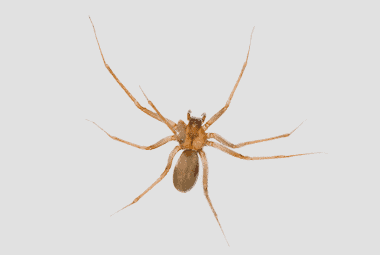For such a tiny spider, the brown recluse sure has a big reputation? Perhaps you've heard some of the stories. Or, perhaps, you've seen some of the unsavory pictures of brown recluse bite wounds. It is also quite possible that you don't believe any of it, and you are of the opinion that it is no big deal to have brown recluse in your home. Either way, we hope to dispel the myths with this article and get to the truth about how dangerous it is to have brown recluse living in your home.
What Makes the Brown Recluse Dangerous?
Tissue-Destroying Bite?
While this is definitely a spider that should be respected, there has been more than a little exaggeration when it comes to the threat of the brown recluse. You are probably aware that brown recluses have venom with necrotic properties. That means the venom destroys living tissue. But the truth is that it doesn't always create a large wound. A bite from a brown recluse can actually be minor, with no spreading of tissue damage. So, does that mean it is no big deal to be bitten by one of these spiders? Well, that depends on where you are bitten. Even a small necrotic wound on the face can lead to a disfiguring scar. And that is not something anyone needs.
Fast-Moving with Great Eyesite?
You may have heard stories that the brown recluse is a fast-moving spider with great eyesight. While this is true, they are also reclusive, as their name suggests. If they notice you coming, they're going to run in the opposite direction. This helps to reduce bites from these spiders. But, when a brown recluse is trapped, it will bite.
Ability to Hide?
The biggest danger brown recluse pose is actually not in how venomous they are or how skilled they are at hunting prey. It is in how well they can survive in human dwellings. Most homes do not have food and water at levels that are sufficient for many bugs, but the brown recluse spiders can tolerate as much as six months in drought conditions and limited food resources. This, combined with its ability to reproduce quickly, can create a significant infestation inside a home. And, while one or two brown recluses in a home will not likely lead to a bite incident, dozens, or even hundreds, could.
How to Identify Brown Recluse
When brown spiders appear in your home, it is important to determine whether or not they are brown recluse spiders. If you see the spider up close, you can look to see if it has the upside-down violin shape on its back. This marking will be dark brown on its light tan skin. You can also look for its six eyes–two of which are close together in the center and may give the appearance of only three eyes.
Brown recluse are a little bigger than a quarter. And, unlike other brown spiders, the recluse is hairless. If you see a smooth, fast-moving brown spider, it is likely to be a brown recluse.
How to Avoid A Brown Recluse Bite?
Though there can be quite a bit of hysteria surrounding the brown recluse, it has no interest in hunting you. You are most likely to get a bite when you bring yourself into contact with one of these spiders. Here are a few ways you can prevent this from happening.
- Check between your sheets before you slide into bed.
- Shake your shoes before you slide your feet into them.
- Shake out clothing before you put it on, especially if it has been lying on the bed or over a chair.
- Be careful when picking up a damp towel from the floor. If possible, refrain from leaving wet towels and clothing on the floor at all.
- If you get a box from the attic or basement, be cautious when opening it.
- Look before you sit. The last thing you want to do is share a seat with a brown recluse spider.
How to Keep Brown Recluses Out of Your Home
Though brown recluses aren't as bad as the myths would have us believe, this is still a pest control problem you definitely don't want to get wrong. We strongly recommend that you contact a pest control company to handle a brown recluse infestation. Through a process of inspection, treatment, and monitoring, a certified professional will be able to determine that the problem has been resolved.
We also recommend that you choose a pest control company that is QualityPro certified. This is a third-party certification from the National Pest Management Association for excellence in pest control service and business practices.
If you're in our Missouri service area, let the QualityPro-certified team here at Rottler Pest & Lawn Solutions help you make sure that your brown recluse issue is resolved, the first time. With our St. Louis exterminators, you'll always get the highest level of pest control with the highest level of service. Schedule your free quote today.


